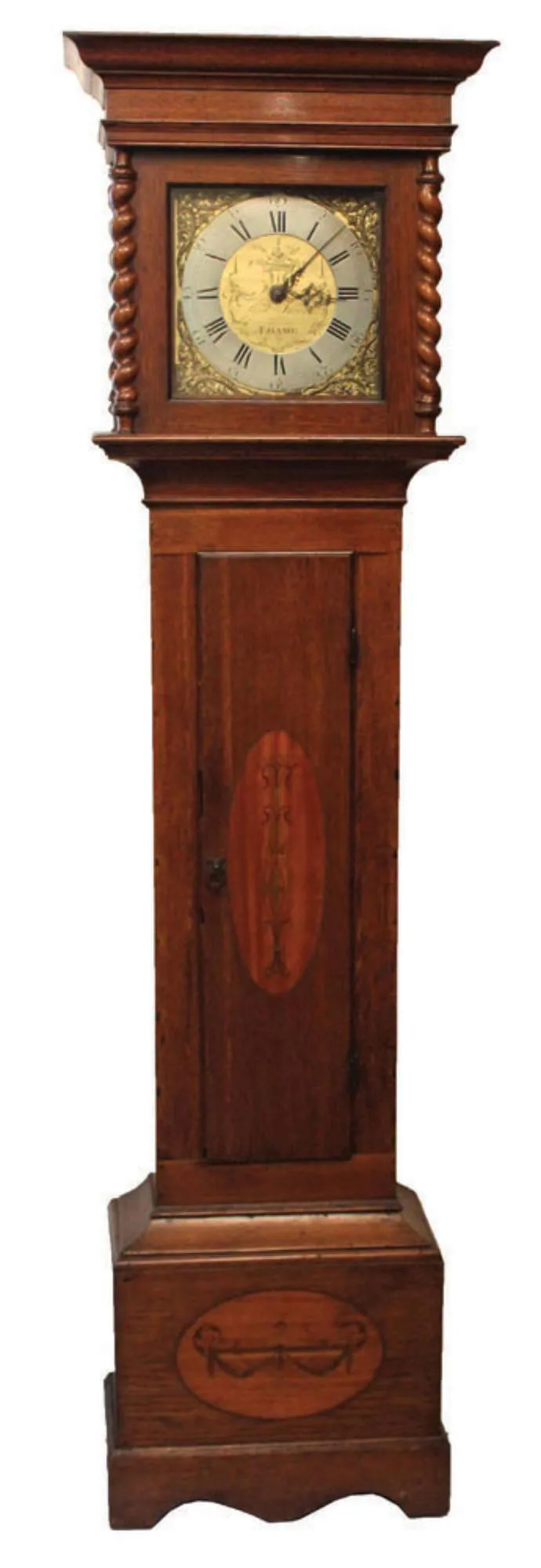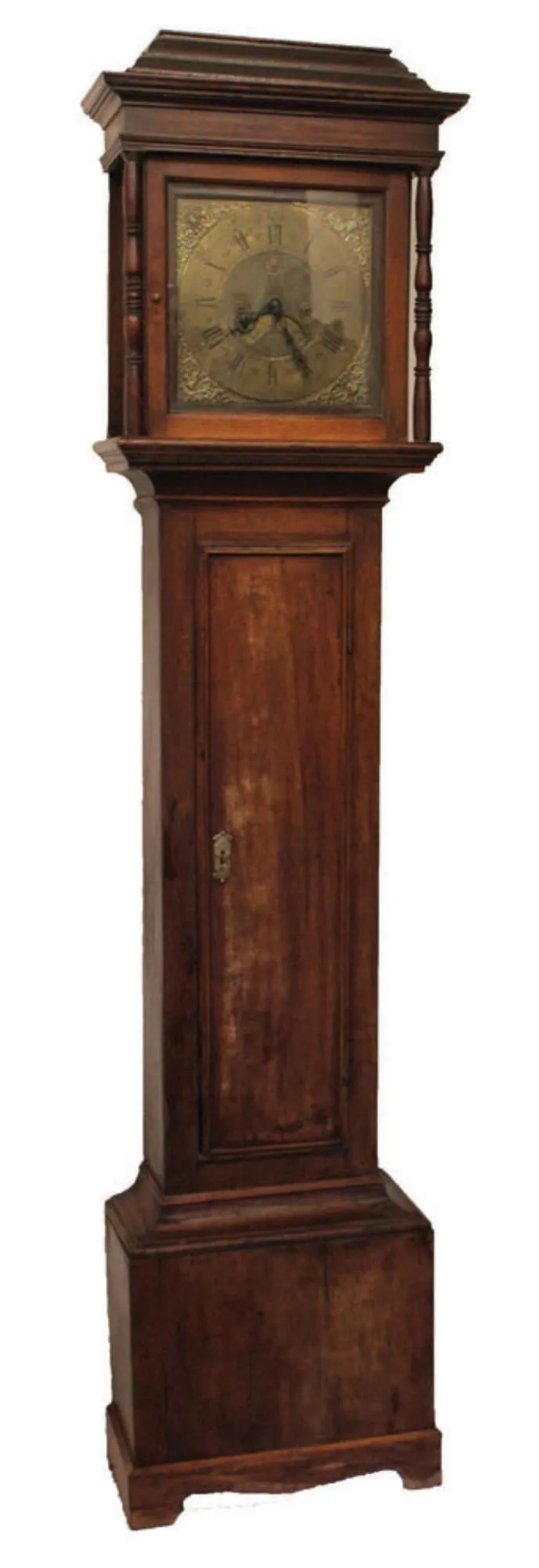![]()
Chapter 1 A Short Introduction to Longcase Clocks
TERMINOLOGY AND THE WORDS: REPAIR, RESTORATION AND CONSERVATION
‘Clock-repairer’ is a term that is used to describe people who correct wear and defects in clocks and although we use the word ‘repair’ rather loosely to cover all corrective procedures, ‘restoration’ is a more appropriate concept for longcase clocks because they are invariably old and could be considered as horological artefacts. In more extreme cases of age, rarity or quality of workmanship, the ‘conservation’ approach implies stabilization and preservation of important heritage objects, even at the expense of functionality.
For clarity, the difference between the concepts of repair and restoration is explained by defining the terms:
- Repair means a purely functional mending process intended to return a clock to working order without any particular consideration of the clock as it was when first made.
- Restoration means returning a clock to its supposed original state sympathetically, using the same style of craftsmanship and materials. An element of heritage value is implied.
- Conservation – unlike museums, private owners of historical clocks generally prefer to have them working rather than in a state of suspended silence, preserved for all time, so the concept of conservation often presents conflicts and difficulties for both owners and conservators. Essentially, conservation means preserving original parts in their original context or relationship, and if some are missing or beyond use, any replacement parts should only be introduced to make sense of the original, with no attempt to mimic what was once there. Likewise, with case-work, new work should only be introduced into a clock-case in order to stabilize and preserve the structure. New work should be clearly identifiable, with no attempt to make new parts that might be mistaken for original. Conservation work should be carefully recorded with illustrated descriptions of the clock and all the work including evidence of previous work or alterations
THE BASIC CONCEPT OF A PENDULUM CLOCK
It is a basic law of physics that over small arcs of swing, and gravitational forces being constant, the time taken for a pendulum to swing from one extremity to the opposite is only dependent on its length. A pendulum clock is designed and built around this isochronous behaviour of simple pendulums.
The movement in a longcase (or any mechanical) clock performs two separate but related tasks: it maintains the swing of the pendulum by giving it a little nudge at each swing to make up for natural damping; and, second, it counts the number of swings, which it shows as seconds, minutes and hours of the day. The word ‘dial’ is derived from the same root as our word ‘day’, because the clock dial is a representation of the day.
HOW THE TWO MAIN TYPES OF LONGCASE CLOCK EVOLVED
The terms, ‘longcase’, ‘tall case’ (in North America) or otherwise ‘grandfather’ are used to describe floor-standing, weight-driven clocks that have their dials approximately at adult eyelevel. A wooden case supports the movement and dial at that convenient height, while providing a vertical space through which the driving weights descend and the approximately one metre-long pendulum swings.
The fact that the pendulum is roughly one metre long is no coincidence: in 1790 the French National Assembly proposed to define the metre as the length of a pendulum with a half-period of one second. (In other words, by that definition, a 1m-long pendulum takes exactly 1sec to swing from one extremity to the other.) In the event, an alternative, geodetic, definition was adopted, so the one-second pendulum is actually 994.16mm or 39.14in.
Since a longcase clock is both functional and decorative, the case is necessarily both structurally sound and aesthetically pleasing. Like all good furniture, a well-designed and made clock-case is the meeting of the craftsman’s hand with the artist’s eye.
From the end of the seventeenth century and into the early eighteenth century, when longcase clocks became fashionable in London, they were fabulously expensive symbols of status and wealth. However, after about 1730, production of longcase clocks in London began to decline as fashions changed once more, this time in favour of bracket clocks. About the same time, there was a rapid expansion in clockmaking activity in the provinces and from then, the continual interpretation of national fashions, coupled with the development of regional styles, usually make deductions possible about when and where a longcase clock might have been made and the status of the first buyers, because longcase-clock ownership ceased to be the sole prerogative of the very wealthy.
By the 1740s, approximately fifteen or twenty years after the general introduction of the break-arch style of longcase dial, longcase clocks had ceased to be at the forefront of London fashion. Thereafter, with the London makers concentrating on bracket clocks, London longcase clocks made after the mid-1700s are surprisingly uncommon.
However, the period also saw the beginnings of a huge proliferation of country longcase clocks throughout the towns and villages of the British Isles. In many instances, young men who had migrated to London to be apprenticed to good makers, returned with their new skills to their native towns and villages. Of the 70,000 clockmakers listed in Brian Loomes’s Directory of Watchmakers and Clockmakers of the World, a very high proportion were working in country towns and villages in the hundred years from the mid-eighteenth century to the end of longcase production in the mid-nineteenth century.
In the first-half of the eighteenth century, as longcase clocks increasingly transcended the social strata, large variations emerged, both in their style and complexity, from plain country versions to the most elaborate examples from the golden age of cabinet-making.
Although movements do not vary much, they usually contain subtle clues about approximate age, but dials and cases continued to develop until the effective end of longcase clock production in the mid- to late nineteenth century, when cheaper mass-produced clocks became widely available.
Within all that variation, there are naturally a number of rules about dating longcase clocks based on their movements, dials and cases, even their hands, but there are exceptions and, with longcase clocks, there are a great many exceptions. The one rule for which there seems to be no exception is that there are no two identical longcase clocks, nor even two identical dials.




